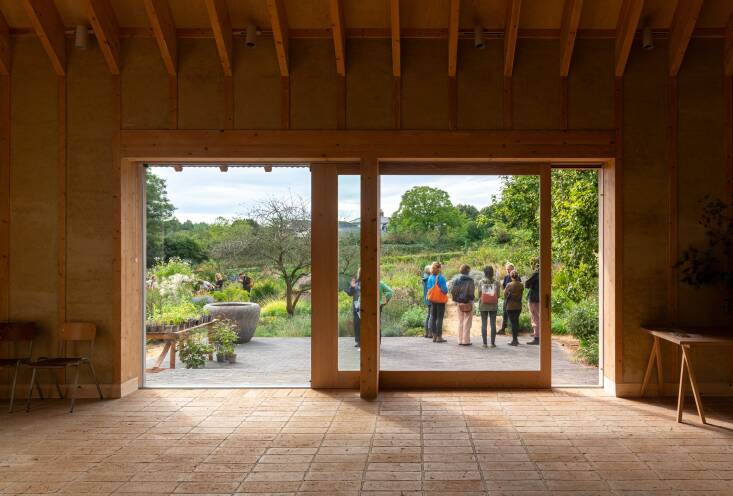The Serge Hill Project for Gardening, Creativity and Health is very much a family affair. The not-for-profit enterprise that opened in June 2024, just north of London’s thundering ring road, the M25, is the brainchild of the internationally renowned landscape architect Tom Stuart-Smith and his psychotherapist wife, Sue. Meanwhile, its stunning central building, the Apple House, was designed by their architect son, Ben, as part of the architecture and design collective Okra. Let’s take a closer look.
Photography by Jiaji Wu.

Situated in an old disused orchard on the family estate that was originally bought by Tom’s grandfather in 1927, the garden is, at its heart, a community project, conceived as a resource for local schools, youth groups, local residents, and charities, including the Sunnyside Rural Trust, which provides horticultural training for people with learning disabilities. Here, the Trust has an onsite nursery where they raise plants for sale. (Long before the opening of Serge Hill Project, Tom had collaborated with the Trust, when they grew the herbaceous plants for his 2021 show garden at the RHS Hampton Court Flower Show.) Serge Hill Project has vegetable plots as well for the local community, and one for Tom’s studio staff, too, who often cook and eat together.
At the center of the orchard is the stunning Apple House, which was built entirely from natural materials, including hempcrete walls, with oak cladding (sourced from a nearby forest) and flooring made from unfired clay tiles. The imposing structure—just as beautiful on the inside as it is on the outside—serves as a gathering place for visiting groups as well as a venue for talks, workshops, and symposia. (So far the Apple House has hosted two events: a two-day workshop on using earth in architecture and landscape, and a day-long one on gardens and health.)

The project was, in part, inspired by Sue’s research for The Well-Gardened Mind, her best-selling 2020 book that investigates the power of gardening to transform our health and mental wellbeing. In the future, the Stuart-Smiths hope that the garden can play a part in local doctors being able to prescribe gardening to their patients.
Tom’s lifetime of horticultural experience has been fundamental in setting up a living plant catalogue, too. After the pandemic, the designer relocated his whole team to a purpose-built studio that sits between his converted barn home and the orchard. And now they also have access to his innovative one-acre plant library featuring 1,600 plants, including herbaceous perennials and bulbs. Each plant is allocated their own square meter (complete with QR codes to identify each grouping), providing a daily resource for his designers to observe them at close range. Drought-tolerant species are planted in six inches of sand, in the drier sunnier conditions at the top of the site; down the slope is a damper, shadier area for plants that prefer more moisture-retentive clay soil. More general conditions, and the plants that like them, are in between. Students, gardeners, and designers can also visit, and in the future the plant library will extend into a paddock next door owned by Tom’s sister, Kate.

As part of the educational aspect of the project, Tom has commissioned ecologist Johnnie Johnson to survey the site. This summer he recorded tawny owls and barn owls in the plant library and found eight species of bats, including three species scarce in the area and the rare Barbastelle. Johnson describe the Apple House, with its innovative oak cladding that is full of nooks and crannies, as “a giant bat house.”

See also:
- The Maestro’s Return: Tom Stuart-Smith at the Chelsea Flower Show
- Garden Visit: Beth Chatto’s Courtyard Scree Garden
- Studio Visit: Claverton Cloches






Have a Question or Comment About This Post?
Join the conversation